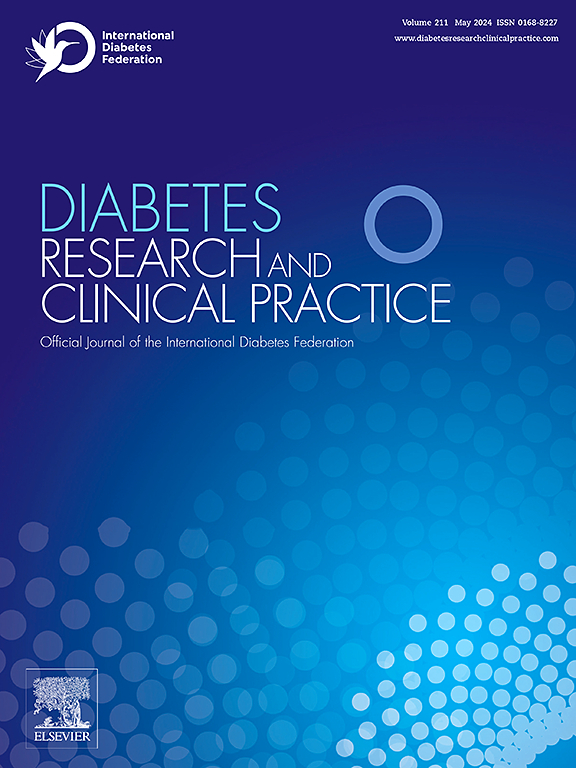Comparison of information provided on diabetes distress when using PAID-20, PAID-11 or PAID-5. A registry-based study applying IRT analyses among 10,190 adults with type 1 diabetes in Norway
IF 6.1
3区 医学
Q1 ENDOCRINOLOGY & METABOLISM
引用次数: 0
Abstract
Aims
To 1) evaluate information provided on the latent diabetes distress trait when using the Problem Areas In Diabetes, 20 item (PAID-20), PAID-11 or PAID-5, and 2) evaluate the information provided by each scale item.
Methods
Using nationwide registry data from 10,190 individuals with type 1 diabetes in Norway, we applied Item Response Theory (IRT) analyses to compare test information curves for PAID-20, PAID-11, PAID-5 and their scale items.
Results
The test information curve for PAID-20 captured an overall broader range of the latent distress trait compared to the other versions. At test information level ≥ 10, the ranges (SD under/above mean) were: PAID-20: −1.30 to 3.32; PAID-11; −1.17 to 2.76; and PAID-5: −0.59 to 2.27. Six PAID-20 items had flat information curves with limited contribution to the latent trait, whereas the PAID-11 included 11 of the 12 items most frequently reported as serious problem areas.
Conclusions
The PAID-20 captures most information on the latent diabetes distress trait; however, the PAID-11 provides comparable information and captures the most serious problem areas. The PAID-5 provided limited information and covers limited aspects of distress. Overall, the PAID-11 may be a good choice for assessing diabetes distress in both research and clinical practice.
使用PAID-20、pay -11或pay -5时提供的糖尿病窘迫信息的比较一项基于登记的研究,应用IRT分析了挪威10190名成人1型糖尿病患者
目的:1)评估使用糖尿病问题领域20 (PAID-20)、pay -11或pay -5时提供的关于潜在糖尿病困扰特征的信息;2)评估每个量表项目提供的信息。方法利用挪威全国10190例1型糖尿病患者的登记资料,应用项目反应理论(IRT)分析比较PAID-20、PAID-11、PAID-5及其量表项目的测试信息曲线。结果与其他版本相比,付费-20的测试信息曲线捕获了更广泛的潜在痛苦特征。在测试信息水平≥10时,范围(SD低于/高于平均值)为:PAID-20:−1.30 ~ 3.32;PAID-11;−1.17 ~ 2.76;PAID-5:−0.59 ~ 2.27。6个付费-20项目的信息曲线平坦,对潜在特质的贡献有限,而付费-11包括12个最常被报告为严重问题领域的11个项目。结论pai -20能捕获潜伏性糖尿病窘迫特征的大部分信息;然而,pay -11提供了可比较的信息,并抓住了最严重的问题领域。pay -5提供了有限的信息,涵盖了有限的痛苦方面。总之,在研究和临床实践中,PAID-11可能是评估糖尿病痛苦的一个很好的选择。
本文章由计算机程序翻译,如有差异,请以英文原文为准。
求助全文
约1分钟内获得全文
求助全文
来源期刊

Diabetes research and clinical practice
医学-内分泌学与代谢
CiteScore
10.30
自引率
3.90%
发文量
862
审稿时长
32 days
期刊介绍:
Diabetes Research and Clinical Practice is an international journal for health-care providers and clinically oriented researchers that publishes high-quality original research articles and expert reviews in diabetes and related areas. The role of the journal is to provide a venue for dissemination of knowledge and discussion of topics related to diabetes clinical research and patient care. Topics of focus include translational science, genetics, immunology, nutrition, psychosocial research, epidemiology, prevention, socio-economic research, complications, new treatments, technologies and therapy.
 求助内容:
求助内容: 应助结果提醒方式:
应助结果提醒方式:


